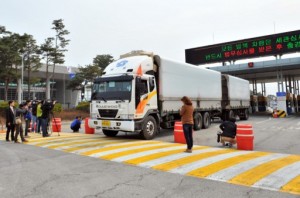South Korea offers North talks, with warning

Photographers take pictures of a South Korean truck arriving from North Korea’s Kaesong joint industrial complex, at a gate of the inter-Korean transit office in the border city of Paju on April 8, 2013. South Korea on April 8 issued another appeal for North Korea to lift an access ban on the Kaesong joint industrial park, which has already forced a dozen South Korean firms to halt operations. AFP FILE PHOTO
SEOUL—South Korea on Thursday offered North Korea formal talks on suspended operations at their joint Kaesong industrial zone, and hinted it might pull out entirely if Pyongyang declines the proposal.
The South said it was offering working-level talks to resolve the impasse over Kaesong, a rare symbol of inter-Korean cooperation that has become the most notable victim of escalating military tensions on the Korean peninsula.
But the offer came with an ultimatum of unspecified “grave action” if Pyongyang fails to accept the proposal within 24 hours.
“There is no change to our government’s firm position that Kaesong should be maintained and developed,” Unification Ministry Spokesman Kim Hyung-Seok said.
“But we cannot let this situation at Kaesong continue as it is,” he added.
Kim did not elaborate on what measures might be taken, but the ultimatum suggested South Korea was considering a permanent withdrawal from the zone, which normally employs 53,000 workers at 123 South Korean companies.
The talks proposal came a day after Seoul announced pan-governmental action to help firms with factories in Kaesong deal with liquidity problems caused by lost production and the cancellation of orders.
Established in 2004 and lying 10 kilometers (six miles) inside North Korea, Kaesong is a crucial hard currency source for the impoverished North, through taxes and revenues, and from its cut of the workers’ wages.
The project was born out the “Sunshine Policy” of inter-Korean conciliation initiated in the late 1990s by South Korean President Kim Dae-Jung which led to a historic summit with North Korean leader Kim Jong-Il in 2000.
It operates as a collaborative economic development zone that hosts South Korean companies attracted by its source of cheap, educated, skilled labor.
Turnover in 2012 was reported at $469.5 million, with accumulated turnover since 2004 standing at $1.98 billion.
The Korean peninsula was already engulfed in a cycle of escalating tensions — triggered by the North’s nuclear test in February — when Pyongyang decided on April 3 to block all South Korean access to Kaesong.
Angered by the South’s defense minister remarks on the existence of a “military” contingency plan to protect South Korean staff in Kaesong, the North then pulled out its entire workforce on April 9 and suspended operations.
Since then it has denied repeated requests to send food and other supplies to South Koreans who opted to remain in the zone to maintain their non-running production lines.
Even given the soaring tensions, the North’s decision to suspend operations at Kaesong was unexpected, as neither side has allowed previous crises to significantly affect the complex.
Permanent closure would wipe out the last remaining point of contact and cooperation between North and South, which remain technically at war after the 1950-53 Korean War was concluded with a ceasefire rather than a peace treaty.
There are currently 176 South Korean staff still in Kaesong, compared with the usual number of around 850.
“The South is likely to order all remaining personnel to pull out of Kaesong,” predicted Cho Bong-Hyun of the IBK Economic Research Institute in Seoul.
“Both South and North Korea are reluctant to become the first one to mention the closure of Kaesong outright in order to avoid responsibility,” Cho told AFP.
Usually hundreds of South Korean managers and other workers pass through the border crossing leading to Kaesong every day.
Some have continued to show up the border crossing on a daily basis in the unrealized hope that the North might lift the access ban.
The bulk of the 123 South Korean firms based in Kaesong are textile units, but there are also machinery, electronics and chemical manufacturers.














